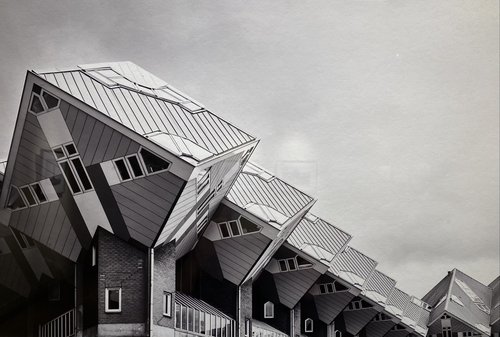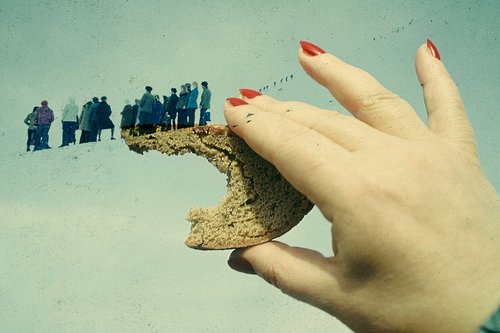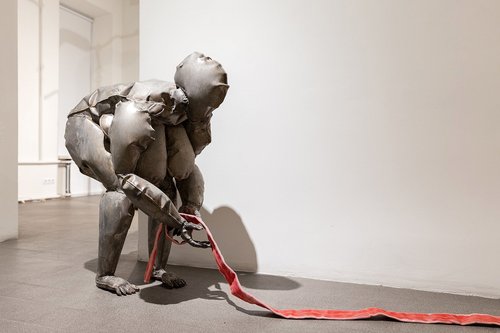Rinat Voligamsi’s Art of the Absurd

Rinat Voligamsi. Human. Exhibition view. Moscow, 2024. Courtesy of 11.12 Gallery
Realism with an unexpected twist perhaps best describes the eccentric art of this midcareer artist from the Russian city of Ufa whose work often goes viral and is represented in many state museums across the country. Currently his work is on view at the 11.12 Gallery in Moscow.
“There’s something is wrong here!” is a classic first reaction to paintings by Rinat Voligamsi (b. 1968). Your eye spots something odd even before you know what it is. At first glance there is an everyday scene in sepia painted to look like a photograph. There is an elderly lady on the pavement feeding pidgeons. Dusk hangs over a village lost in snow-covered plains. A group of army officers are standing next to each other, chattering away. So where does this feeling of unease come from? Look again. The elderly lady turns out to be feeding a flock of tiny dinosaurs. The cottages in the village literally stare out at you from the semi-darkness with strange paired round windows that look like eyes. And the officers are standing with their bootlaces are tied together – no, actually they all share one single bootlace which creeps like a snake from one foot to another!
Voligamsi joined the Artists’ Union in 2000 and is represented by a well-established Moscow gallery, unusual for an artist from outside the mainstream. He had a solo show at the Moscow Museum of Modern Art in 2018 called Dvoegorsk, dedicated to an imaginary small town in the Russian provinces, a place where strange things happen daily. His works have been acquired by MMOMA as well the State Russian Museum in St. Petersburg and the state museums of Omsk and Krasnoyarsk.
Hamlet’s phrase ‘The time is out of joint’ is a good description of Voligamsi’s whimsical visual world. His pseudonym itself is a key to his creative method. He reversed his last name, Ismagilov, quite common in his native Bashkortostan – a region in the Urals mountains – to create an exotic moniker. Likewise, in his paintings he depicts everyday situations yet by adding or changing a few details, he brings a touch of otherworldliness that turns banal scenes into something grotesque, phantasmagoric, even haunting. The effect is surreal, but the artist firmly denies any connections with Surrealism as a style. “Surrealism is an automatic recording of the workings of the subconscious,” he told me, speaking over the phone from his studio in Ufa. “The subconscious produces something, and the artist records it. Only afterwards he wonders what it was that he had created. But I don’t work like that, I think everything out in advance, I spend a lot of time making sketches”. His personal record was 350 digital sketches for just one work. He starts with photographs and combines and alters them beyond recognition. Just one photo is never enough, it takes up to 50 different images to compose a view of a nondescript Russian village to which he will then add some quirky details. “What I do is the art of the absurd”.
Is that the absurdity of life in Russia today? “It’s not a specifically Russian absurd,” the artist disagrees. “It is my own absurd. I use images familiar to me.” He was born and raised in a small village in Bashkortostan, and it was there that he first got interested in photography. He received his first camera as a gift for his 13th birthday and started taking pictures of relatives and neighbours. “I am still working with aesthetics from my childhood days, black-and-white snapshots, badly printed, stained, over-exposed”. His first successful project which became viral on the internet long before the era of memes, was a mockumentary photographic series, telling the Monty-Python-style alternative version of the life of Lenin and his imaginary twin brother Sergey. In Voligamsi’s ‘Unofficial Album,’ the pair go through a series of absurd adventures: instead of dying at the age of 53, Vladimir Lenin somehow acquires a harem of three wives, is reconciled with Trotsky in Mexico and lives to advanced age smoking cigars in Havana. What started as a light-hearted experiment with Photoshop evolved into an ironic deconstruction of the Soviet myth, where Lenin’s life was hypocritically embellished with numerous ‘warm’ and ‘human’ details by Soviet propaganda.
Voligamsi has been taking photos since he was a teenager yet has never thought of photography as a profession. He was trained as an architect at Ufa’s State Technical Oil-Mining University a career path which did not suit him. “I tried to fight back with the architecture,” he recalls. “I excluded things like perspective and space from my artworks”. So, at some point, he started to create objects, prematurely aged, deliberately crude welded sculptures from rusted steel – mostly village cottages, similar to the ones from his paintings. Some are turned inside out, others pierced by monstrous nails or distorted in other ways. Architecture may have won over him, but certainly still keeps fighting back.
This same sense of the absurd pervades his sculptures and paintings. It somehow looks perversely natural, as if it is inherent in life, grows out of the very texture of reality, like an enormous mushroom suddenly popping out from the ground. Giant mushrooms are a recurring theme in Voligamsi’s art, too. On his canvases, they invade villages like aliens from outer space, their caps rising high above the roofs. (Characteristically, this image, however fantastic, is not that far from reality. Only in fact, it is not mushrooms, but a giant species of grass from Caucasus mountains, called Sosnowski’s hogweed, toxic to humans and animals, that is taking over the fields and villages in many parts of the country.) Voligamsi challenges conventional perception by twisting the most common visual tropes – iconic images of the Russian countryside, such as birch trees or wooden dachas that are almost identical all over the country. Both undergo an endless sequence of bizarre transformations in his works. Does he deny architecture? Or anything else? “I don’t deny anything,” he objects. “I agree with everything. It’s just a game I play – which I also offer up to the viewer for their own enjoyment”.


















